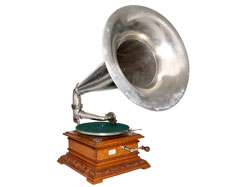
|
Deutscher Text "Machines parlantes perfectionnées „Kaléophone“, Maurice Dufossée, Ingénieur Mécanicien, 158 rue Lafayette, Paris". So steht es auf der Plakette des Grammophons. Dufossée liess das „Kaléophone“ 1905 in Paris amtlich registrieren. Bei diesem Gerät handelt es sich aber nicht um eine Eigenkonstruktion Dufossées, sondern um ein Grammophon, das von der Schweizer Firma Paillard in Ste-Croix hergestellt und ursprünglich als „Maestrophone No.3“ verkauft wurde. Typisch für dieses „Maestrophone“ ist die Kurbel, die nicht wie üblich an der Seite, sondern an der Front angebracht wurde. Beim Motor handelt es sich um das gleiche Modell, welches von Paillard auch im Modell „Autophone“ eingebaut wurde. Der vernickelte Trichter ist 65 cm lang und hat einen Durchmesser von 45 cm. Das „Kaléphone“ ist ein wunderbares Beispiel
dafür, wie aus einem Schweizer Grammophon ein Exportartikel
wurde, der schliesslich als Eigenmarke Bestandteil im Katalog eines
ausländischen Händlers wurde. |
English Text "Machines parlantes perfectionnées "Kaléophone, Maurice Dufossée, Ingénieur Mécanicien, 158 rue Lafayette, Paris". Dufossée let the "Kaléophone" 1905 officially registered in Paris. This example is not a self-construction, but a gramophone, which was prepared by the Swiss company Paillard at Ste-Croix and originally called "Maestrophone No.3". Typical of this "Maestrophone" is the crank, which is not attached to the side as usual, but at the front. It is fitted by the same drive that was used by Paillard in there gramophones, sold as model "Autophone". The nickel-plated horn is 26’ long and has a diameter of 16’. The "Kaléphone" is a wonderful example of how
a Swiss phonograph became an export item and finally to the brand
of a foreign merchant.
|